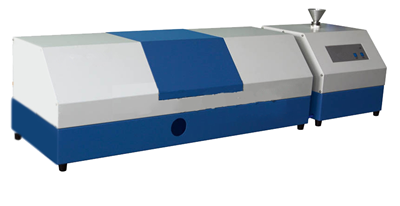
Specifications:
1, measuring range: 0.1 to 600 microns
2. Accuracy: <± 1% (national standard D50)
3. Repeatability: <± 1% (national standard D50)
4, Power: AC 220 ± 10V, 50Hz, 200W
5. Dimensions: Host: 1000 × 330 × 300mm, dry injection system: 350 × 330 × 300mm
6, Weight: 40KG
Dispersion method
System includes a laser particle size analyzer, automatic dry dispersion system, composed of Silent oil free air compressor, high efficiency condenser section. In the dry state after the sample by automatic dry powder feeder uniformly conveyed to the high pressure gas stream, driven by high-pressure air is injected into the continuous high-speed disperser, has been fully dispersed in the sample arrives at the outlet of the dispersion through the laser beam sample into the collector, while the computer shows the particle size distribution of information at once.
1. Dry dispersion without any dispersing agent and a solvent.
Dispersion pipe friction shear forces.
Friction between particle collisions generated shear forces.
Collisions between particles and dispersion pipe wall.
2. Using Silent oil free air compressor, a condenser with high efficiency, guaranteed to produce clean compressed air.
3. instantaneous dispersion, instantaneous measurement, test accuracy, high efficiency of the analysis, from sample to a result within a minute.
Principle:
Mie scattering theory with full-scale, fully taking into account the refractive index of the optical properties of the particles and the dispersion medium measured particle size distribution data, depending on the size of the particles in each angle scattered light intensity changes on the anti-particle group performances.
Particle sizing calculations are generally divided into unconstrained fitting inversion and the constrained fitting inversion. Constrained fitting inversion before the calculation assumes that match a certain distribution of particle group, according to the law of inverse particle size distribution. This type of operation is relatively simple, but because of prior assumptions inevitably exists between the reality of bias, thereby testing the constrained fitting data do not reflect the actual particle size distribution of the particles.
Unconstrained fitting inversion test before the particle does not make any assumptions, by light intensity directly and accurately calculate the size distribution of particles. Such assumptions are reasonable detector and particle classification, to make high demands on the device itself. SKZ1062 laser particle size Analyzer, using optimum of non-uniform cross-dimensional fan-shaped array of detector arrays and reasonable size grading, making it possible to accurately measure particle size distribution.
Technical characteristics:
Testing stable basis: only system capable of providing a stable optical signal can fully guarantee the stability of test data. Using he-ne gas laser, wavelength of 0.6328 Micron, short wavelengths, line width is narrow, good stability, and more than 25,000 hours of service life, can be very good for the system to provide a stable laser source signal.
Data reliable guarantee: to ensure reliable test data, first is the rational design of signal detection system, effect of the measured sample dispersion and uniformity of dispersion being measured, is another decisive factor for real results obtained.
Detectors: photoelectric detection system unique design, high sensitivity, a main detector, multiple auxiliary detector, three-dimensional non-uniformity of the cross-sector matrix arrangement, the maximum detection angle of 90 degrees, and fully guarantee the signal detection of comprehensiveness.
Optical path: using a range of design, unique converged light way, reducing the Fourier lens group, the measurement range is wider, higher-resolution, optical path free transfer.
Analysis Software:
PADMAS particle size measurement and analysis system (Particle Diameter Measure & Analysis System) is powerful, test data can be done: average, statistics, comparison, and mode conversion processing, the differential distribution, the cumulative distribution, standard grade, RR distribution, custom grading, by columns and quantity grade distribution. Default grading 130 within 0.02 to 2000 microns, within the range from 1 to 130 can be customized classification. Test report has particle size distribution and particle size of the graphic data table, there are D10, D50, D90, the average particle size and specific surface area and other characteristic parameters, with four custom parameter input according to requirements, the weight ratio of surface area to volume ratio of the surface area may be interchanged. Particle size data can be saved to EXCEL. Support Chinese and English test report format printing, headers and footers can be modified as needed, have a print preview feature, able to put particle size distribution graphs and data charts saved as an image or PDF format to facilitate interaction with the use of WORD. According to user needs, increase other processing functions. Operation is simple: standards, quantification, simple operation can be mastered in a short time, the test data is complete within one minute.
Strong visibility: Testing friendly software interface, the testing process is clearly visible, instantaneous refresh, visibility, and can be observed at any time of the instrument operating conditions, fluctuations in clear conditions of test data, analysis of the measured data authenticity and reliability.
Cycle, ultrasound, stirring and draining operation keys are on the intelligent touch control panel, standard, quantification, simple operation, shorten test time and reduce the operator’s requirements.


